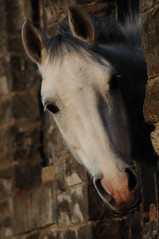Stable Management – Electrolytes What You should Know

![]() photo credit: spakattacks
photo credit: spakattacks
Hot and sweating horses go hand in hand and with it comes the loss of electrolytes. What are electrolytes and why are they so important? Read the following ‘primer’ to educate yourself on what exactly electrolytes do and why they are important to our horses.
As we exercise our horse it generates energy in the form of heat. To dissipate the heat from the body the horse sweats. The sweat evaporates from the horse’s body to help regulate the body temperature. If the horse didn’t sweat their body temperature would rise to dangerously high levels.
How Much to Horses Sweat
To determine how much sweat a horse produces horses were weighed before and after exercise and the following was determined:
Type of work/exercise Range of weight loss (lbs)
Standardbred 12 – 33
After a 1 mile race
Field Hunter (after 3 hour fox hunting) 24 – 100
Thoroughbred (after race training or breezing) 10 – 16
Endurance horses (after 54mile race) 22 – 88
To think that a horse can loose 100 pounds of sweat is enormous. The water in sweat comes from within the horses body but also from individual cells. When cells are recruited for sweat the body takes water from the blood plasma. When this occurs and sweat losses are large, it may affect the delivery of blood to the muscles and inhibit the ability of the horse to continue working properly.
What is Sweat
Sweat is a concoction of sodium, chloride and potassium. There is also calcium, magnesium, trace minerals and protein present. It has been tested that Chloride is present in the highest concentration followed by sodium and potassium.
How to tell if your horse is dehydrated

![]() photo credit: sk8geekThe easiest test is the neck ‘pinch’ test. At the base of the neck graba fold of the horse’s skin. If the skin remains tented for more than a second, then the horse is showing signs of dehydration.
photo credit: sk8geekThe easiest test is the neck ‘pinch’ test. At the base of the neck graba fold of the horse’s skin. If the skin remains tented for more than a second, then the horse is showing signs of dehydration.
Check the horse’s gums. The gums should appear a pink colour and when pressed the colour should immediately return. If a white depression or thumbprint remains then the horse is dehydrated.
Getting a horse to drink is important and sometimes owners and trainers do some pretty inventive things to get them to drink.
- Some trainers flavour the drinking water with apple juice or drink crystals, like kool-aid, for several days before going to a show or event. This will help if horses are finicky and won’t drink the water at the event if it has a different smell or even taste a bit different.
- Sometimes horses tend to drink if the bucket is held for them.
- They also tend to drink more if they see other horses drinking.
Getting Electrolytes into Your Horse
Electrolyte supplementation is not usually necessary for horses in regular exercise that have a balanced ration, access to hay and grass, water and free choice salt block. If however, they are racing, performing endurance activities or worked hard several days in a row the expenditure of electrolytes may be excessive and the horse may require additional electrolytes.
Purchasing an electrolyte mix is the easiest way to supplement the loss of electrolytes. Making a home mix can also be done. Using a mix of Sodium Chloride, Potassium Chloride, Calcium (carbonate/acetate) and Magnesium (oxide) in the proportions of 60:30:5:5 (source:http://www.aera.asn.au/qera/veterinary/electrolytes.html).
An average rule of thumb is to replace 1-3 grams of sodium for every litre of water the horse drinks. If the horse is sweating (and loosing sodium) a lot it is important to replace this only if the horse has drunk the equivalent amount of water. For example if the horse is sweating heavily and the horse may be sweating out as much as 6 grams of sodium in his sweat every hour “but you can only replace this if he has drunk around 6 litres of water each hour”.
- Most horse diets are deficient in sodium. Adding common table salt to the diet or free choice salt lick is one way to make sure that horses get ample sodium.
- Most horses need little in the way of supplemental sodium. In times of heavy work, excessive heat and humidity or extreme training conditions may require the addition of electrolytes into the diet.
- Dehydration can be worsened if electrolytes are over supplemented. Excessive electrolytes are eliminated from the body in the urine, not stored for later use.

 Try these three powerful exercises to get strengthen your position.
Try these three powerful exercises to get strengthen your position.
